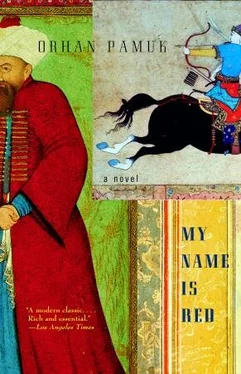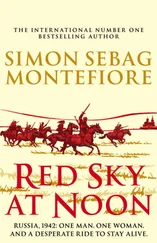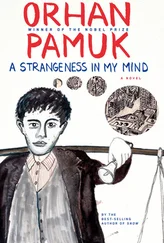Would I, perchance, have any idea where unfortunate Elegant Effendi might be?
What did he mean “unfortunate”! I didn’t say that Elegant Effendi was a worthless plagiarist, a fool who did his gilding for money alone with nary a hint of inspiration. “Nay,” I said, “I do not know.”
Had I ever considered that the aggressive and fanatical followers of the preacher from Erzurum might’ve done Elegant Effendi harm?
I maintained my composure and refrained from responding that Elegant Effendi himself was no doubt one of their lot. “Nay,” I said. “Why?”
The poverty, plague, immorality and scandal we are slave to in this city of Istanbul can only be attributed to our having distanced ourselves from the Islam of the time of Our Prophet, Apostle of God, to adopting new and vile customs and to allowing Frankish, European sensibilities to flourish in our midst. This is all that the Preacher Erzurumi is saying, but his enemies attempt to persuade the Sultan otherwise by claiming that the Erzurumis are attacking dervish lodges where music is played, and that they’re defacing the tombs of saints. They know I don’t share their animosity toward His Excellency Erzurumi, so they’re making polite insinuations: “Are you the one who has taken care of our brother Elegant Effendi?”
It suddenly dawned on me that these rumors had long been spreading among the miniaturists. That group of uninspired, untalented incompetents was gleefully alleging that I was nothing but a beastly murderer. I felt like lowering an inkpot onto the Circassian skull of this buffoon Black purely because he took the slander of this jealous group of miniaturists seriously.
Black was examining my workshop, committing everything he saw to memory. He was intently observing my long paper scissors, ceramic bowls filled with yellow pigment, bowls of paint, the apple I occasionally nibbled as I worked, the coffeepot resting on the edge of the stove in the back, my diminutive coffee cups, the cushions, the light filtering through the half-opened window, the mirror I used to check the composition of a page, my shirts and, over there, my wife’s red sash caught like a sin in the corner where she’d dropped it as she quickly quit the room upon hearing Black’s knock at the front door.
Despite the fact that I’ve concealed my thoughts from him, I’ve surrendered the paintings I’ve made and this room I live in to his bold and aggressive gaze. I sense this hubris of mine will be a shock to you all, but I am the one who earns the most money, and therefore, I am the best of all miniaturists! Yes, God must’ve wanted the art of illumination to be ecstasy so He could demonstrate how the world itself is ecstasy to those who truly see.
At about the time of midday prayer I heard a knock at the door. It was Black from long ago, from our childhood. We embraced. He was chill and I invited him inside. I didn’t even ask how he’d found his way to the house. His Enishte must have sent him to question me about Elegant Effendi’s absence and his whereabouts. Not only that, he also brought word from Master Osman. “Allow me to ask you a question,” he said. “According to Master Osman, ”time“ separates a true miniaturist from others: The time of the illustration.” What were my thoughts? Listen closely.
Painting and Time
Long ago, as is common knowledge, the illustrators of our Islamic realm, including, for example, the old Arab masters, perceiving the world the way Frankish infidels do today, would regard everything and depict it from the level of a vagabond, mutt or clerk at work in his shop. Unaware of today’s perspectival techniques, of which the Frankish masters haughtily boast, their world remained dull and limited, restricted to the simple perspective of the mutt or the shop clerk. Then a great event came to pass and our entire world of illustration changed. Let me begin here.
Three Stories on Painting and Time
ALIF
Three hundred fifty years ago, when Baghdad fell to the Mongols and was mercilessly plundered on a cold day in the month of Safar, Ibn Shakir was the most renowned and proficient calligrapher and scribe not only of the whole Arab world but of all Islamdom; despite his youth, he had transcribed twenty-two volumes, most of which were Korans and could be found in the world-famous libraries of Baghdad. Ibn Shakir believed these books would last until the end of the world, and, therefore, lived with a deep and infinite notion of time. He’d toiled heroically all through the night by flickering candlelight on the last of those legendary books, which are unknown to us today because in the span of a few days, they were one by one torn up, shredded, burned and tossed into the Tigris River by the soldiers of the Mongol Khan Hulagu. Just as the master Arab calligraphers, commited to the notion of the endless persistence of tradition and books, had for five centuries been in the habit of resting their eyes as a precaution against blindness by turning their backs to the rising sun and looking toward the western horizon, Ibn Shakir ascended the minaret of the Caliphet Mosque in the coolness of morning, and from the balcony where the muezzin called the faithful to prayer, witnessed all that would end a five-centuries-long tradition of scribal art. First, he saw Hulagu’s pitiless soldiers enter Baghdad, and yet he remained where he was atop the minaret. He watched the plunder and destruction of the entire city, the slaughter of hundreds of thousands of people, the killing of the last of the Caliphs of Islam who’d ruled Baghdad for half a millennium, the rape of women, the burning of libraries and the destruction of tens of thousands of volumes as they were thrown into the Tigris. Two days later, amid the stench of corpses and cries of death, he watched the flowing waters of the Tigris, turned red from the ink bleeding out of the books, and he thought about how all those volumes he’d transcribed in beautiful script, those books that were now gone, hadn’t in the least served to stop this horrifying massacre and devastation, and in turn, he swore never to write again. Furthermore, he was struck with the desire to express his pain and the disaster he’d witnessed through painting, which until that day, he’d belittled and deemed an affront to Allah; and so, making use of the paper he always carried with him, he depicted what he saw from the top of the minaret. We owe the happy miracle of the three-hundred-year renaissance in Islamic illustration following the Mongol invasion to that element which distinguished it from the artistry of pagans and Christians; that is, to the truly agonizing depiction of the world from an elevated Godlike position attained by drawing none other than a horizon line. We owe this renaissance to the horizon line, and also to Ibn Shakir’s going north after the massacre he witnessed-in the direction the Mongol armies had come from-carrying with him his paintings and the ambition for illustration in his heart; in brief, we owe much to his learning the painting techniques of the Chinese masters. Thereby, it is evident that the notion of endless time that had rested in the hearts of Arab calligrapher-scribes for five hundred years would finally manifest itself not in writing, but in painting. The proof of this resides in the fact that the illustrations in manuscripts and volumes that had been torn apart and vanished have passed into other books and other volumes to survive forever in their revelation of Allah’s worldly realm.
BA
Once upon a time, not so very long ago yet not so recently, everything imitated everything else, and thus, if not for aging and death, man would’ve never been the wiser about the passage of time. Yes, when the worldly realm was repeatedly presented through the same stories and pictures, as if time did not flow, Fahir Shah’s small army routed Selahattin Khan’s soldiers-as Salim of Samarkand’s concise History attests. After the victorous Fahir Shah captured Selahattin Khan and tortured him to death, his first task in asserting his sovereignty, according to custom, was to visit the library and the harem of the vanquished khan. In the library, the late Selahattin Khan’s experienced binder pulled apart the dead shah’s books, and rearranging the pages, began to assemble new volumes. His calligraphers replaced the epithet of “Always Victorious Selahattin Khan” with that of “Victorious Fahir Shah” and his miniaturists set about replacing the late Selahattin Khan-masterfully portrayed on the most beautiful of manuscript pages-who was, as of that moment, starting to fade from people’s memories, with the portrait of the younger Fahir Shah. Upon entering the harem, Fahir Shah had no difficulty in locating the most beautiful woman there, yet instead of forcing himself upon her, because he was a refined man versed in books and artistry, and resolving to win her heart, he engaged her in conversation. Consequently, Neriman Sultan, the late Selahattin Khan’s belle of beauties, his teary-eyed wife, made but one request of Fahir Shah: that the illustration of her husband in a version of the romance Leyla and Mejnun , wherein Leyla was depicted as Neriman Sultan and Mejnun as Selahattin Khan, not be altered. In at least this one page, she maintained, the immortality that her husband had tried to attain over the years through books should not be denied. The victorious Fahir Shah bravely granted this simple request and his masters of the book left that one picture alone. Thereby, Neriman and Fahir immediately made love and within a short period, forgetting the horrors of the past, came to truly love each other. Still, Fahir Shah could not forget that picture in Leyla and Mejnun . Nay, it wasn’t jealousy that made him uneasy or that his wife was portrayed with her old husband. What gnawed at him was this: Since he wasn’t painted in the old legend in that splendid book, he wouldn’t be able to join the ranks of the immortals with his wife. This worm of doubt ate at Fahir Shah for five years, and at the end of a blissful night of copious lovemaking with Neriman, candlestick in hand, he entered the library like a common thief, opened the volume of Leyla and Mejnun , and in place of the face of Neriman’s late husband, drew his own. Like many khans who had a love for illustrating and painting, however, he was an amateur artist and couldn’t portray himself very well. In the morning, when his librarian opened the book on a suspicion of tampering and beheld another figure in place of the late Selahattin Khan, next to Neriman-faced Leyla, rather than identifying it as Fahir Shah, he announced that it was Fahir Shah’s archenemy, the young and handsome Abdullah Shah. This gossip provoked Fahir Shah’s soldiers and emboldened Abdullah Shah, the young and aggressive new ruler of the neighboring country, who, subsequently, in his first campaign, defeated, captured and killed Fahir Shah, established his own sovereignty over his enemy’s library and harem and became the new husband of the eternally beautiful Neriman Sultan.
Читать дальше












